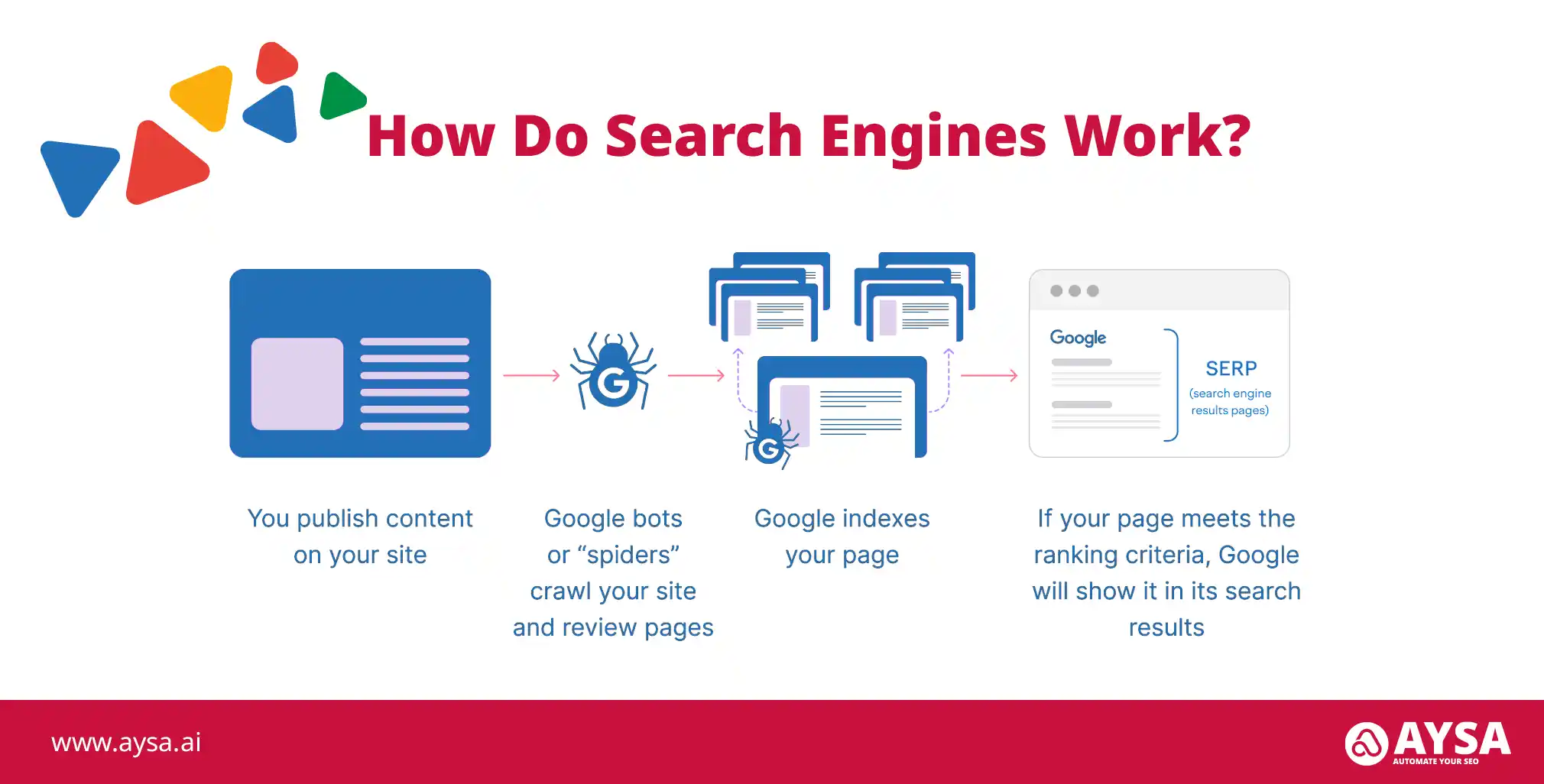
What is SEO?
SEO, or search engine optimization, encompasses a series of strategies designed to enhance a website’s presence in search engine results, such as those from Google, thereby increasing organic traffic.
The essence of SEO is to meet users’ search intentions through the production of pertinent, superior content and delivering an optimal user experience.
Understanding SEO – The Ins and Outs: SEO efforts are multifaceted, extending both within a website and beyond it. This comprehensive approach is often segmented into “on-page” and “off-page” SEO.
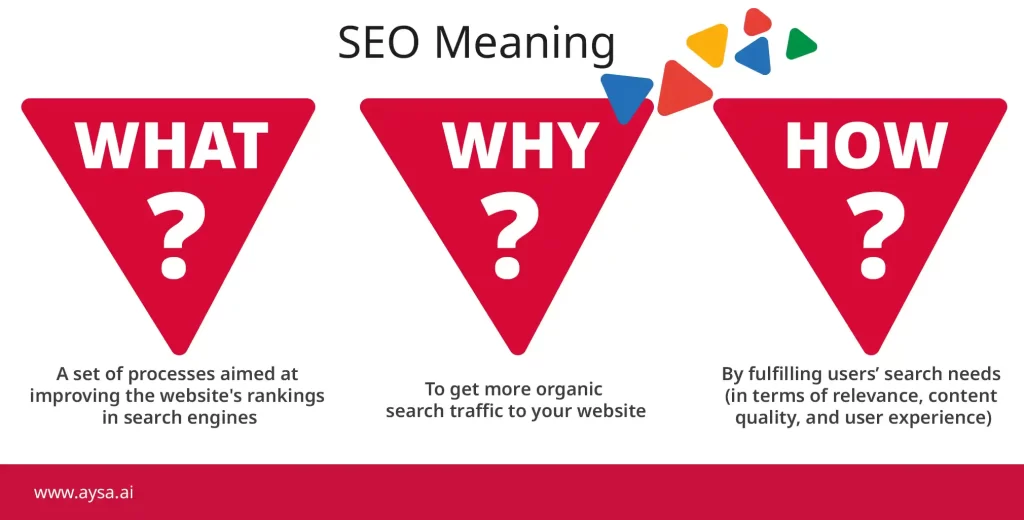
Practically, effective SEO includes:
- Investigating Keywords: Identifying and analyzing terms and phrases that potential visitors might type into a search engine helps guide content strategy and overall marketing tactics.
- Crafting and refining content: producing high-quality, valuable content that utilizes those keywords to meet user needs and adjusting existing content to make it more relevant and engaging.
- Enhancing Technical Aspects: Improving site structure, ensuring fast load times, creating a mobile-friendly interface, and other technical elements that affect a website’s performance in search rankings
- Building Links: Developing a portfolio of inbound links from reputable sources, which act as endorsements to enhance a website’s trustworthiness and authority, are crucial factors in search rankings.
Why does SEO matter?
Every single day, billions of queries are made on Google for various information and products. Understandably, search engines often serve as the primary traffic drivers for many websites.
To tap into this vast source of traffic, it’s crucial to be prominently listed in the search results for your chosen keywords.
It’s straightforward: the higher your website ranks, the more visitors it attracts.
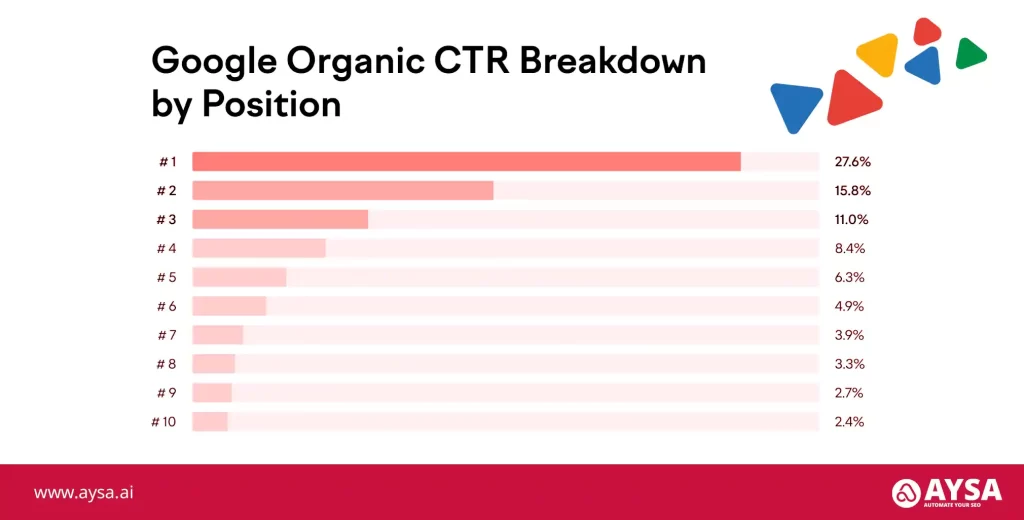
- Top Position Dominance: The search result that ranks in the #1 position receives a significantly higher CTR (27.6%) compared to the rest. This highlights the importance of aiming for the top spot in search results.
- Steep Drop after #1: After the top spot, there’s a notable decline in CTR. The second position has a CTR of 15.8%, and the third position gets 11.0%.
- Decreasing CTR: As you move down the ranking positions, there’s a consistent decrease in CTR. By the time you reach the 10th position, the CTR is only 2.4%.
- Importance of Top 3 Positions: The first three search results collectively garner a much higher portion of clicks compared to the rest, indicating the prominence of being within the top 3 results on Google.
Organic click-through rates by ranking position on Google Moreover, the first three organic listings garner over half of all the clicks.
This underscores the significance of SEO.
Optimizing for search engines is instrumental in elevating your rank. Elevated rankings lead to increased traffic, which in turn translates to acquiring new clientele and amplifying brand visibility.
In essence, overlooking SEO is akin to sidelining one of the most potent sources of traffic, giving your rivals an unchallenged playing field.
SEO vs. PPC: A Comparison
Search engine results pages (SERPs) primarily showcase two distinct categories:
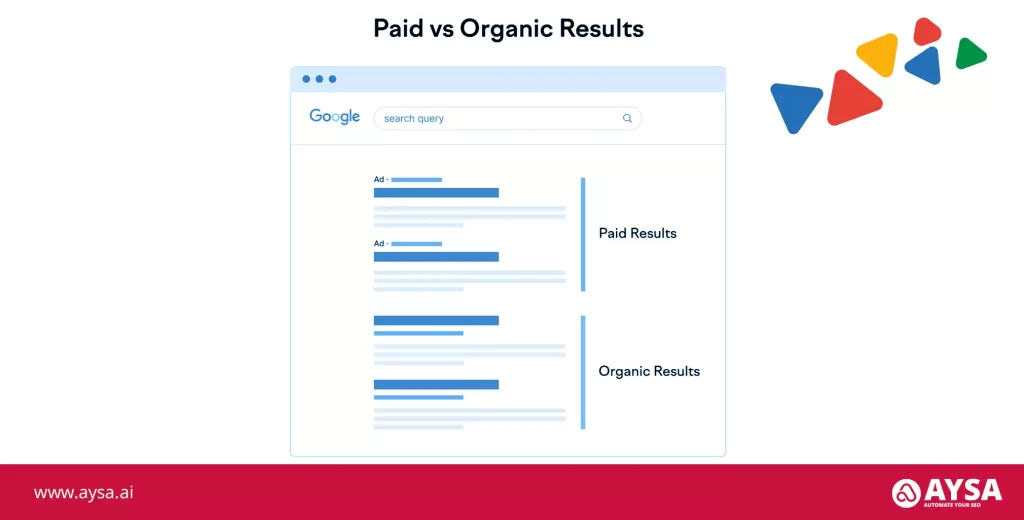
- Paid Listings: These positions are acquired through pay-per-click (PPC) campaigns.
- Organic Listings: Achieving these spots requires optimizing your website through SEO. A glimpse of paid and organic search listings
One might ponder: Why not directly invest in the advertisement section?
The reasoning is straightforward. The lion’s share of users tend to bypass ads and focus on organic listings.
Indeed, while SEO demands greater commitment, energy, and investment for “cost-free” organic visitors, the payoff is worth it.
By securing high rankings for your desired keywords, you’re enabled to tap into a steady stream of traffic that remains unaffected even if you halt any monetary expenditure.
Understanding Search Engines: A Deep Dive
At the heart of every search engine lies a simple mission: to delight users with the most relevant and valuable results.
For this purpose, search engines strive to identify the crème de la crème of pages and present them as the foremost search outcomes.
A side note: While various search engines exist, Google stands out as the crowd favorite.
Hence, it’s often the benchmark when discussing search mechanics. Nevertheless, core SEO principles remain consistent across different search platforms.
To discover and prioritize content, Google undergoes these phases:
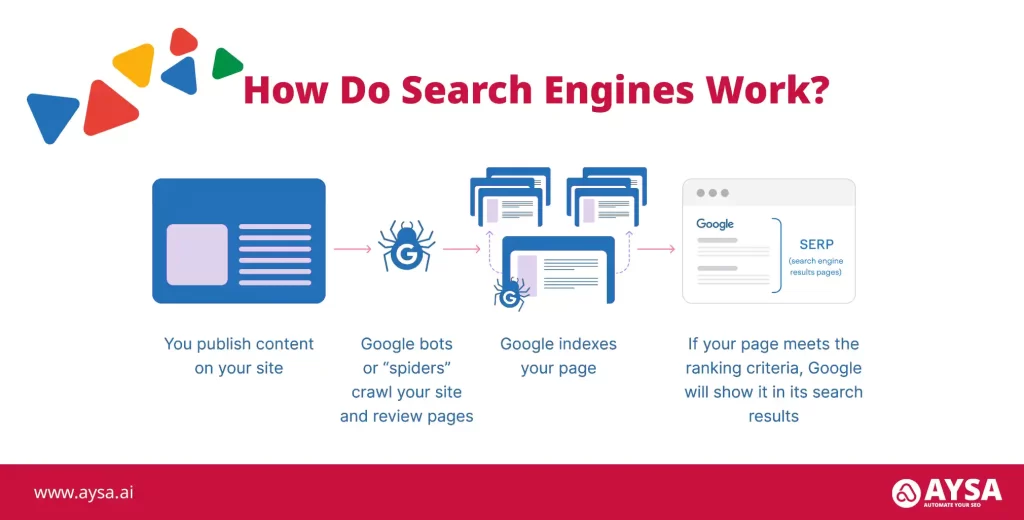
- Crawling: Employing “spiders” or software robots, Google scours the internet for fresh or revised pages. For a page to be recognized, there must be at least one active link leading to it.
- Indexing: Subsequently, Google scrutinizes each page, deciphering its essence. This data might then be cataloged in the vast Google Index, an extensive repository of online pages.
- Result Display: Upon receiving a search inquiry, Google evaluates pages for their merit and pertinence, subsequently orchestrating them in the SERP.
This facilitation is achieved via a series of measures and established guidelines, often termed technical SEO.
With this foundational knowledge of Google’s modus operandi, it’s pivotal to delve deeper into the determinants of top-ranking results. And to discern SEO’s instrumental role therein.
Understanding SEO Mechanics
Google employs intricate methods, termed “algorithms,” to determine the ranking of pages.
These algorithms consider a vast array of ranking elements to pinpoint the ideal position for a given page.
While you needn’t grasp the inner workings of these algorithms entirely (indeed, no one truly does), understanding the foundational concepts can illuminate your path to successful SEO endeavors.
Prioritizing Relevance: Your foremost responsibility in SEO is to curate pertinent content.
And why is this paramount?
Because Google’s primary mission is to present users with pertinent search outcomes,
Relevance isn’t merely about displaying dog-related pages when someone searches for “dogs.”
It transcends this simplistic view, delving into meeting the underlying motive or intent behind a user’s search.
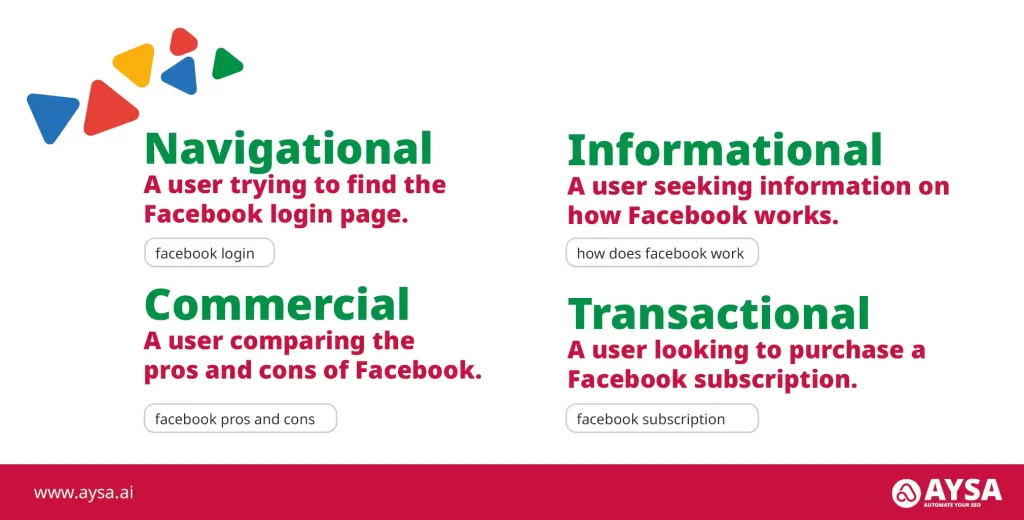
This search intent can be broadly classified into four categories:
- Navigational (for instance, “facebook login”)
- Informational (such as, “how does facebook work”)
- Commercial (like, “facebook pros and cons”)
- Transactional (example, “facebook subscription”)
For instance, when you enter “best dog food” into a search engine, you’re not expecting to find articles discussing various dog diets or instructions for preparing homemade dog food. While these are related to the topic, they don’t align with your search intent.
Drawing from the behavior of millions of users, Google understands that a search like “best dog food” typically indicates a readiness to purchase. Therefore, Google prioritizes product pages or reviews of top-rated dog foods, recognizing that the searcher’s intent is likely transactional or commercial.
Google SERP for “best dog food” Wondering how to ensure your content meets the search intent?
Thankfully, Google lays the groundwork for you. Your task is to examine the existing search results and decode their patterns.
To craft content that resonates with search intent, keep the following in mind:
- Topical relevance: Google discerns the theme of a page through its keywords. While it’s crucial to optimize your content with keywords, moderation is key to avoiding over optimization.
- Nature of content: Ascertain the appropriate content format by observing the current top-ranking results for your keyword. These could range from landing pages and product listings to informative articles or reviews.
- Content freshness: Certain queries demand the latest information, especially news articles or recent product reviews. For these topics, your content needs regular updates to remain relevant.
- Geographical context: Search results can vary based on the user’s location. If location impacts your content, tailor your approach to reflect this (for example, adhere to local SEO strategies if you’re a local enterprise).
Crafting High-Caliber Content
Identifying the optimal keywords is merely your starting point.
The journey continues with generating content that not only incorporates these keywords but is also poised to rank highly for them. The twin engines driving SEO are indeed content creation and optimization.
When queried about the paramount element for securing a top spot in search results, Google’s John Mueller succinctly responded:
@methode @JohnMu What’s the crucial factor in positioning a website at the pinnacle of search results for a specific phrase?
— Saroj Kumar (@sarojnishad) September 6, 2017 Achieving prominent Google rankings requires your content to stand out as one of the top 10 resources for the subject at hand.
With each SERP featuring 10 organic results on its initial page, that’s your target destination.
Distinguishing superior content from the average involves several critical factors:
- Depth and Breadth: Don’t just skim the surface; delve deep into the topic to address any queries your audience might pose. It’s not about the sheer volume of words but about furnishing searchers with a comprehensive guide.
- Originality: Steer clear of merely rehashing what’s already out there. Your content should bring something new to the table, be it a fresh perspective, invaluable insights, practical examples, or innovative visuals.
- E-A-T Criteria: Experience, expertise, authoritativeness, and trustworthiness (E-A-T) are crucial for Google. It’s vital to offer precise, dependable data, establish yourself as a subject matter expert, and showcase your credentials, both through your website and externally.
- Clarity and Structure: Ensure your prose is accessible and digestible. This involves logical organization, concise sentences, active voice preference, and maintaining a consistent narrative style, among others.
Initiating the Process
After delving into keyword research, your next move is to embark on the content creation journey.
Assessing content quality can be nebulous, but utilizing a resource like Aysa.ai, SemRush, aHrefs can offer some clarity.
Usually the content is measured based on
- Readability
- SEO
- Originality
- Tone of Voice
What is Readability
Readability refers to how easily a text can be read and understood, playing a pivotal role in engaging and retaining reader interest.
One widely utilized method to determine this is the Flesch Reading Ease score formula. While the formula’s core structure remains consistent, it’s important to note that the coefficients adjust for languages other than English, including German, French, Spanish, Italian, Dutch, and Portuguese.
The formula for calculating the Flesch Reading Ease score in English is:
206.835 – (1.015 x (total words / total sentences)) – (84.6 x (total syllables / total words))
This score provides a quantifiable measure of a text’s complexity: the higher the score, the more accessible the content is. Here’s how to interpret these scores:
- 90-100: Comparable to a 5th-grade reading level. Very straightforward, easily grasped by an average 11-year-old.
- 80-90: Similar to a 6th-grade level. Relaxed, conversational language suited for a broad audience.
- 70-80: Approximate to a 7th-grade level. Reasonably simple to understand.
- 60-70: Matches 8th or 9th-grade comprehension. Clear and uncomplicated language that caters to 13- to 15-year-olds.
- 50-60: Resonates with 10th to 12th-grade complexity. Presents more challenge in terms of comprehension.
- 30-50: Aligns with college-level reading. Demands a higher degree of concentration and vocabulary.
- 0-30: Suited for college graduates. Highly challenging and best comprehended by individuals with advanced education.
An effective strategy is to aim for a readability score that mirrors the average seen in content ranking in Google’s top 10 for your targeted keywords. This approach ensures your content is neither overly simple nor excessively complex, aligning with the expectations and preferences of your target audience.
What is SEO as measurement
In the SEO section, several crucial elements are measured to ensure your content is optimized for better visibility and ranking on search engines. Here’s what’s typically assessed:
- Target Keywords:
- These are central to your content and all associated recommendations. It’s imperative to incorporate these keywords in your text at least once.
- Recommended Keywords:
- To augment your content’s SEO performance, it’s advisable to sprinkle these suggested keywords throughout your text. These could include terms like “web pages,” “broken links,” “keyword research,” “crawl and index,” “SEO,” which stands for Search Engine Optimization, “landing pages,” “higher rankings,” “technical SEO,” “click-through rate,” “user experience,” “blog posts,” “search engine results page,” “search queries,” “search engine result,” “organic traffic,” “meta description,” “ranking factors,” “long-term,” “internal links,” and “how search engines work.”
- Alt Attribute Issues:
- Adding images not only makes your text more engaging but also offers SEO benefits. However, it’s important to address any alt attribute issues to improve accessibility and keyword relevance in image descriptions.
- Link Issues:
- Incorporating links enhances your content’s authority and usefulness. However, you need to ensure these links are functional and relevant to avoid negative SEO impacts. This involves fixing or removing broken links and ensuring proper link distribution between internal and external sources.
By addressing these areas, you enhance the SEO quality of your content, making it more likely to achieve higher rankings on search engine results pages (SERPs), attract more organic traffic, and provide a better user experience.
Each of these elements is interconnected, contributing to the overall effectiveness of your SEO strategy.
Originality in Content
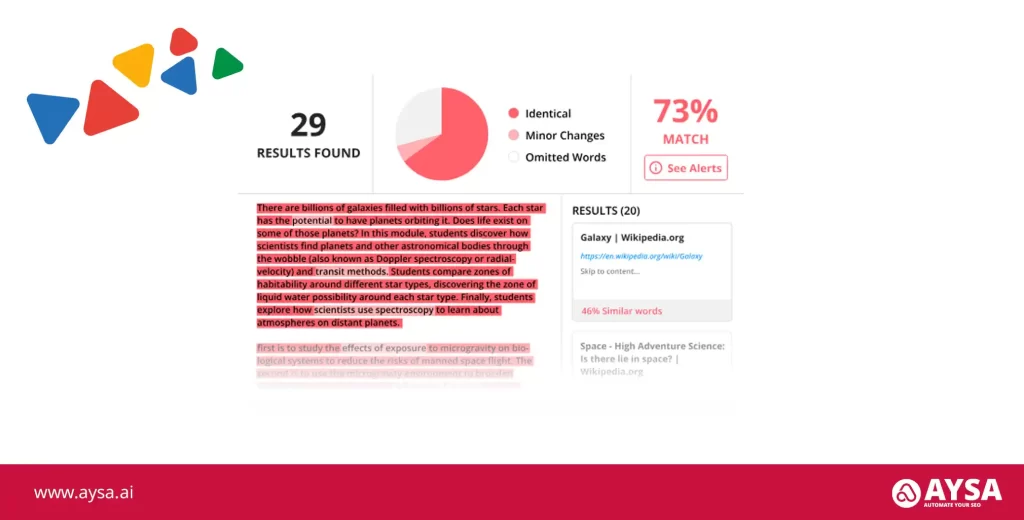
“Originality” refers to the aspect of content that is fresh, unique, and not previously published elsewhere. In the context of content creation and SEO, originality is crucial for several reasons:
- Plagiarism Avoidance:
- Copying content from other sources without proper attribution can lead to serious legal consequences and ethical issues. Plagiarized content damages your credibility and trustworthiness among your audience and peers.
- Search Engine Ranking:
- Search engines like Google prioritize unique content. If your content is found to be duplicated or too similar to existing content, it can severely harm your website’s SEO performance. Google and other search engines can penalize your site by lowering its ranking or, in extreme cases, removing it from search results altogether.
- Audience Engagement:
- Original content is more likely to engage your audience, encouraging them to spend more time on your page and return for new content. This engagement can lead to higher conversion rates and foster brand loyalty.
- Establishing Authority:
- By creating original content, you demonstrate thought leadership in your field. Unique insights, analyses, or perspectives can establish your brand as an authority in your niche, making you the go-to source for information.
Therefore, before publishing, it’s imperative to verify your content’s originality. There are various tools available online that can help you check for plagiarism, ensuring your content maintains the uniqueness necessary to stand out and perform well both in terms of user engagement and search engine rankings. This process protects your reputation and contributes to a more trustworthy, authoritative digital presence.
Tone of Voice: Infusing Your Message with Character and Distinction
Tone of voice encompasses more than the content of your message; it’s the manner in which you convey it — the selection of words, their sequencing, rhythm, and speed. A well-thought-out tone of voice can foster trust and set your brand apart in a sea of competitors.
We assess the formality level of your prose on a nuanced scale, illustrated here:
- Very casual: “Worst. Idea. Ever.”
- Somewhat casual: “Not sure that’s a smart move.”
- Neutral: “There was no need for this suggestion.”
- Somewhat formal: “The proposal was unnecessary.”
- Very formal: “The proffered suggestions were neither sought nor considered beneficial and, hence, have been disregarded.”
This Tone of Voice score is ascertained using an advanced machine learning algorithm. It’s anchored in scientifically credible research and honed with thousands of human-evaluated texts.
When it comes to determining the ideal tone of voice, consider these guiding points:
- Imagine a dialogue: Picture yourself in a verbal interaction with a client, maybe during a call or a personal meeting. Consider the type of language you’d instinctively use.
- Use your customers’ vernacular: Delve into how your customers discuss your products or services. Adopting their manner of speaking can build rapport and a sense of community.
- Adapt to your audience: The most effective tone for your content depends on your audience, the context of your message, and your brand’s persona. It’s not a universal solution but should be adapted to resonate with these aspects.
Your tone of voice is more than a style; it’s a strategic embodiment of your brand’s personality. It connects with your audience on an emotional level, builds relationships, and encourages continued engagement.
Enhancing User Experience
Google favors websites that prioritize user experience.
Technical SEO is crucial in this aspect, not just for ensuring your website’s crawlability and indexability, but also for confirming that your site aligns with essential usability standards.
Key factors include:
- Website Security: It’s imperative that your website conforms to established security benchmarks, such as employing an SSL certificate to shift from HTTP to the more secure HTTPS protocol.
- Loading Speed: Google gives higher rankings to pages that load quickly, as speed directly correlates with a positive user experience.
- Adaptability to Mobile: Google’s “mobile-first indexing” means the search engine assesses your content based on how well it performs on mobile devices. Effective mobile SEO guarantees that your content is easily accessible and consumable for mobile users.
- Navigational Simplicity: Your website should boast a clear, intuitive structure, enabling visitors to swiftly locate what they need and move through your site seamlessly, free of hindrances.
In essence, by focusing on these aspects, you not only optimize your site for search engines but also make it more amiable for users, which can lead to higher engagement rates, return visits, and conversions.
Cultivating Digital Trustworthiness
Search engines rely on numerous off-page indicators to gauge a site’s trustworthiness, with backlinks—hyperlinks from external websites to your own—serving as one of the most potent signals and ranking factors.
Imagine a diagram illustrating the transfer of authority from one page to another via links. Backlinks are akin to endorsements in the digital realm, informing search engines of your content’s credibility.
The authority your page commands in Google’s algorithm is generally bolstered by the volume of high-caliber links it garners, potentially boosting its rankings.
This underscores why link building, the art of acquiring backlinks, is a vital facet of SEO.
There’s a myriad of strategies for effective link building, such as:
- Developing link-worthy resources: Produce content of exceptional value that naturally magnetizes links, like unique research findings, engaging interactive content, or complimentary utilities.
- Contributing guest articles: Pen content for external websites with the strategic intent of establishing backlinks to your site.
- Capitalizing on broken links: Identify defunct links on other sites, then propose your content as an apt replacement.
When cultivating links, prioritize the caliber of connections over sheer numbers.
A solitary link from a site with substantial authority is more impactful than a hundred links from sites deemed low-quality or irrelevant.
Certainly, the goal is to secure numerous links, but they must originate from pertinent, high-quality sources that resonate with your site’s theme.
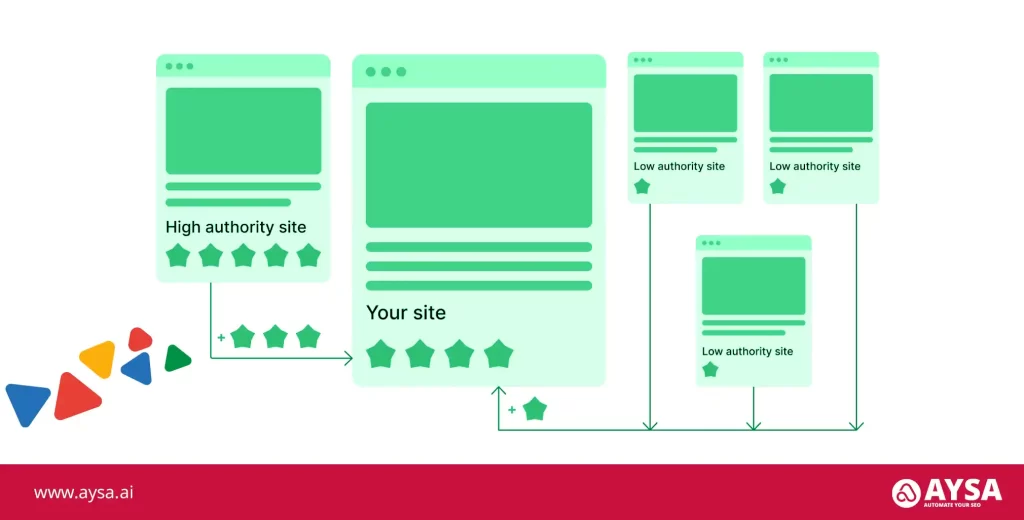
While Google’s evaluation focuses on individual pages rather than entire websites, the cumulative backlinks your site attracts can sway the ranking of specific pages.
How so?
Via internal linking—establishing hyperlinks that weave from one page on your site to another—you can distribute authority among your pages, mirroring the process occurring with inbound links from external sources.
This tactic should be front-of-mind during your internal linking process, ensuring your pivotal pages receive a robust network of internal links.
“It’s one of the most substantial actions you can undertake on your website to direct both Google and your visitors towards the pages you deem paramount.”
Reflecting on the significance of internal linking, Google’s John Mueller emphasized,
Unveiling Realities: 7 SEO Principles
Understanding what SEO entails is one thing; grasping its underlying realities is another. Here are seven fundamental truths to internalize as you set forth on your SEO expedition:
- SEO isn’t a scheme to outsmart Google. Rather, envision it as a strategy to persuade Google to feature your page prominently by demonstrating its user-centric value.
- SEO transcends mere gimmicks. Avoid the perpetual quest for the latest SEO shortcuts or hacks. More often than not, mastering and consistently applying basic SEO principles is your ticket to success.
- SEO demands patience. Tangible outcomes from SEO strategies don’t materialize overnight, barring certain exceptions—like rectifying a significant glitch. Typically, SEO requires a long-term mindset, measuring progress in months, not days.
- SEO goes beyond plugin installation. While SEO plugins are invaluable, their mere integration doesn’t render your website instantly optimized for search engines.
- SEO is an ongoing journey. It’s not a destination you can arrive at and declare completion. Even if you clinch the top spot for your desired keywords, continuous enhancement is crucial—competitors are relentless, and so must you be.
- Insight into your audience is crucial. A profound understanding of your target demographic (be it customers, readers, or subscribers) simplifies the crafting of a potent SEO blueprint.
- SEO is a single piece of a larger mosaic. Regardless of your optimization prowess, neglecting the essence of your enterprise—your product or service—renders all SEO efforts futile.
SEO: Frequently Asked Questions
To wrap up, here are concise answers to some frequently asked questions regarding SEO.
1. What Function Does SEO Serve in Digital Marketing? SEO’s primary role in digital marketing is to enhance a website’s visibility within search engine results, making it an integral component of any comprehensive digital marketing plan. It not only complements PPC campaigns but also intersects with various other marketing sectors, including content marketing and social media initiatives.
2. Is It Possible to Undertake SEO On My Own? Absolutely, SEO isn’t exclusively for professionals or agencies. With a commitment to learning and a platform to implement your strategies, such as your website, you can certainly manage your SEO. It requires no specific expertise, just a dedication to learning and applying new concepts.
3. How Should I Begin My SEO Education? While this guide serves as an excellent initiation into the world of SEO, those wishing to delve further or those with a preference for video tutorials will find a wealth of resources at Semrush Academy. The platform offers an array of free online courses, delivered by renowned industry authorities like Eric Enge, Brian Dean, and Nathan Gotch.
4. Is an SEO Tool Essential? For effective SEO, your strategies should be informed by precise data. Especially for profit-generating websites, investing in a comprehensive SEO toolset is vital. Such a toolset will cater to all your SEO requirements, and the investment will quickly show returns through improved site performance and visibility.


